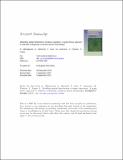Files in this item
Modelling spatial distributions of alpine vegetation : a graph theory approach to delineate ecologically-consistent species assemblages
Item metadata
| dc.contributor.author | Mikolajczak, A. | |
| dc.contributor.author | Maréchal, D. | |
| dc.contributor.author | Sanz, T. | |
| dc.contributor.author | Isenmann, M. | |
| dc.contributor.author | Thierion, V. | |
| dc.contributor.author | Luque, Sandra | |
| dc.date.accessioned | 2016-09-11T23:34:20Z | |
| dc.date.available | 2016-09-11T23:34:20Z | |
| dc.date.issued | 2015 | |
| dc.identifier | 216799146 | |
| dc.identifier | 0195db8b-6754-4362-85f9-102c2beee83b | |
| dc.identifier | 84948576126 | |
| dc.identifier | 000366876400023 | |
| dc.identifier.citation | Mikolajczak , A , Maréchal , D , Sanz , T , Isenmann , M , Thierion , V & Luque , S 2015 , ' Modelling spatial distributions of alpine vegetation : a graph theory approach to delineate ecologically-consistent species assemblages ' , Ecological Informatics , vol. In press . https://doi.org/10.1016/j.ecoinf.2015.09.005 | en |
| dc.identifier.issn | 1574-9541 | |
| dc.identifier.other | RIS: urn:F077A07C77C457062130832269BB1908 | |
| dc.identifier.uri | https://hdl.handle.net/10023/9470 | |
| dc.description | This work was partly funded by the French Ministry of Ecology, Sustainable Development and Energy in support of the development of the CARHab project (2011-2015) on mapping the terrestrial habitats of France. In addition, this work benefited from a synergy with the Divgrass project (Plant Functional Diversity of Permanent Grasslands) (CESAB/FRB funded, France). | en |
| dc.description.abstract | Safeguarding biodiversity has been one of the most important issues on the environmental and forest policies agenda since the 1990's. The problem remains in terms of decisions and knowledge on where to set appropriate conservation targets. Hence, we need detailed and reliable information about habitat structure and composition and methods for estimating this information over the whole spatial domain. In answer to this target, in France, the Ministry of Ecology launched an ambitious project to map the terrestrial vegetation at a scale of 1:25 000 known as CarHab. This project initiated in 2011, will be used as a strategic spatial planning tool in answer to key issues in relation to biodiversity, conservation, green infrastructures and to report on the conservation status of habitats and species of community interest. We use species-distribution models (SDMs) to identify areas that are ecologically suitable for the presence of species based on specific habitat characteristics. Available techniques using graph theory enable identification of groups of species (assemblages) based on ecological affinities. Species co-occurrences (present within the same assessment plot), revealing a shared ecological niche, are analysed using algorithms derived from graph theory in order to define different nodes of species affinities. Thus, the resulting assemblages are based on ecological similarities. Hence, these assemblages are used to develop models of the potential distribution of alpine vegetation communities. The BIOMOD platform is used to facilitate the simultaneous implementation of different modelling approaches that can be compared in order to choose the most suitable and accurate for each species assemblage obtained from graph theory. Using the different relevant spatially explicit results provides a more comprehensive vision of the communities' spatial distributions. | |
| dc.format.extent | 1714992 | |
| dc.language.iso | eng | |
| dc.relation.ispartof | Ecological Informatics | en |
| dc.subject | Habitat modelling | en |
| dc.subject | Alpine vegetation | en |
| dc.subject | BIOMOD | en |
| dc.subject | Graph theory | en |
| dc.subject | Vegetation assemblages | en |
| dc.subject | Conservation planning | en |
| dc.subject | Biodiversity mapping | en |
| dc.subject | GE Environmental Sciences | en |
| dc.subject | 3rd-NDAS | en |
| dc.subject | SDG 15 - Life on Land | en |
| dc.subject.lcc | GE | en |
| dc.title | Modelling spatial distributions of alpine vegetation : a graph theory approach to delineate ecologically-consistent species assemblages | en |
| dc.type | Journal article | en |
| dc.contributor.institution | University of St Andrews. Geography & Sustainable Development | en |
| dc.contributor.institution | University of St Andrews. Centre for Geoinformatics | en |
| dc.identifier.doi | 10.1016/j.ecoinf.2015.09.005 | |
| dc.description.status | Peer reviewed | en |
| dc.date.embargoedUntil | 2016-09-11 |
This item appears in the following Collection(s)
Items in the St Andrews Research Repository are protected by copyright, with all rights reserved, unless otherwise indicated.

